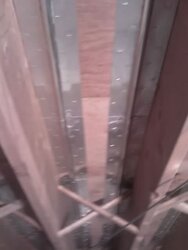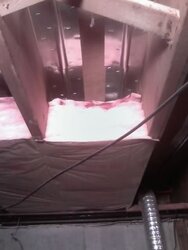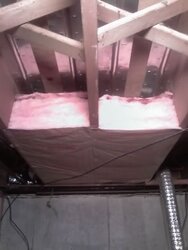Ok I finally got something done with my staple up radiant floor heat, I have only one third of the house done, but that is good considering the stuff I had to move to do it. With all of the great information on this forum and the internet, I decided to do it this way. First I ran two loops of half inch o2 barrier pex in each run about 8 inches apart, it really was not that much more cost and I believe that it will give me a more responsive floor, as others have said. Also I used the aluminum plates which I made myself with 6 inch flashing and a press that I made with 2X4's and some half inch pex pipe, works very well.
I put the plates on the entire run of the pipe where I could; again I believe this also would make a more responsive floor and help lower the temp that I have to run through the pipe, which is my main goal. Below the pipe I insulated with 6 inch fiberglass, before putting the fiberglass up I taped that foil stuff on the top for a reflector.
Now this was really not hard but it is labor intensive, and more so because I had to move all of the junk around that was on the floor like 6 times. As far as cost I have about $400.00 or less in that one zone which is a little more then a third of the house, now this is not including a circ pump.
At first I was planning on using my dhw to run through the floor and control the temp with a tempering valve, but after thinking about it I decided to run my storage water directly through the floor, and use a tempering valve to control the water temp in the floor.
However as I surfed the net one day and came across this thermostat https://www.azeltec.com/customer/product.php?productid=16187&cat=0&page;=
This thermostat controls the floor temp, at the same time it calls for heat in the room, it basically will turn the circulator off and on to maintain the floor temp to what you set it to until the room temp is reached and satisfied.
So I decided that this may be a better approach, it will control the floor temp regardless of the water temp flowing in the pipe. This would save me some money and hassle in installing tempering valves. I have already ordered the thermostat, so I will just have to try it to see if this approach will work, has anyone got any thoughts on this approach?
Steve
I put the plates on the entire run of the pipe where I could; again I believe this also would make a more responsive floor and help lower the temp that I have to run through the pipe, which is my main goal. Below the pipe I insulated with 6 inch fiberglass, before putting the fiberglass up I taped that foil stuff on the top for a reflector.
Now this was really not hard but it is labor intensive, and more so because I had to move all of the junk around that was on the floor like 6 times. As far as cost I have about $400.00 or less in that one zone which is a little more then a third of the house, now this is not including a circ pump.
At first I was planning on using my dhw to run through the floor and control the temp with a tempering valve, but after thinking about it I decided to run my storage water directly through the floor, and use a tempering valve to control the water temp in the floor.
However as I surfed the net one day and came across this thermostat https://www.azeltec.com/customer/product.php?productid=16187&cat=0&page;=
This thermostat controls the floor temp, at the same time it calls for heat in the room, it basically will turn the circulator off and on to maintain the floor temp to what you set it to until the room temp is reached and satisfied.
So I decided that this may be a better approach, it will control the floor temp regardless of the water temp flowing in the pipe. This would save me some money and hassle in installing tempering valves. I have already ordered the thermostat, so I will just have to try it to see if this approach will work, has anyone got any thoughts on this approach?
Steve




